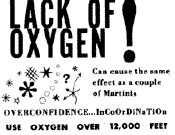Hypoxia
Sometimes called mountain sickness or altitude sickness, hypoxia is simply a lack of oxygen at the tissue level of the body due to a decreased partial pressure of oxygen in the inspired air. Hypoxia is serious, because it may lead to death.
A syndrome, anoxia, meaning literally "without oxygen," is occasionally and erroneously used to denote a deficiency, rather than a lack of oxygen in the tissues. This term is not used for flight below 55,000 feet. Even in acute cases the tissues are never entirely without oxygen.
CAUSES
Hypoxia may be caused by climbing to an altitude where the body is susceptible to a loss of arterial oxygen below that required by the body.
Equipment failure, either a mechanical malfunction or exceeding the capabilities of the design, of a pressurized aircraft or a supplemental oxygen system, can lead to loss of arterial oxygen.
TYPES
Hypoxia poses a real danger to pilots. There are several types.
-
Histotoxic Hypoxia – This
form results from tissue poisoning such as from alcohol,
narcotics, and certain poisons. The utilization of oxygen by the
body tissues is interfered with and the tissues are unable to
metabolize the delivered oxygen.
-
Hypemic Hypoxia – The inability of oxygen to
bind to the hemoglobin, as a result of a large blood loss,
chronic anemia (decreased hemoglobin content), or the forming of
compounds with hemoglobin (carbon monoxide, nitrites, sulfa
drugs) that reduces the amount of hemoglobin available to form
oxyhemoglobin.
- SMOKERS BEWARE: Carbon monoxide has an affinity for the blood 20 times greater than oxygen. Given a choice between carbon monoxide and oxygen, the hemoglobin will choose the carbon monoxide. A regular smoker has a physiologic altitude of 3,000 to 8,000 feet while at sea level.
-
Hypoxic Hypoxia – This is a lack of oxygen as a
result of a high altitude (decreased oxygen pressure) or by
conditions that prevent or interfere with the diffusion of
oxygen across the
alveolar membrane (asthma, pneumonia, tumors, arterial venous shunts).
- Stagnant Hypoxia – This is attributable to a malfunction of the circulatory system resulting in a decrease in blood flow. Causes include high g-loading, exposure to extreme hot or cold temperatures, or by shock.
SYMPTOMS
Hypoxia symptoms are diverse, varying from person to person, depending on variables such as absolute altitude, rate of ascent, duration at altitude, ambient temperature and physical activity.
Individual factors include: inherent tolerance, physical fitness, emotionality, and acclimatization.
It is felt that if a person has attended physiologic training and has determined his individual character for the onset of hypoxia, that character identify remains the same.
STAGES OF HYPOXIA
- INDIFFERENT STAGE – The only adverse effect is on dark adaptation.
- COMPENSATORY STAGE – Physiological compensations provide some defense against hypoxia so that the effects are reduced unless the exposure is prolonged or unless exercise is undertaken. Respiration may increase in depth or slightly in rate, and the pulse rate, the systolic blood pressure, the rate of circulation, and the cardiac output increases.
-
DISTURBANCE STAGE – In this stage the
physiological compensations do not provide adequate oxygen for
the tissues.
Subjective symptoms may include fatigue, lassitude (state of exhaustion), somnolence (drowsiness, sleepiness), dizziness, headache, breathlessness, and euphoria.
Objective symptoms include:
Special Senses – Both the peripheral and central vision are impaired and visual acuity is diminished.
Extraocular muscles are weak and incoordinate – Touch and pain are diminished or lost. Hearing is one of the last senses to be impaired or lost.
Mental Processes – Intellectual impairment is an early sign and makes it improbable for the individual to comprehend his own disability. Thinking is slow. Calculations are unreliable.
Memory is faulty. Judgment is poor. Reaction time is delayed.
Personality Traits – There may be a release of basic personality traits and emotions as with alcoholic intoxication (euphoria, elation, pugnaciousness, overconfidence, or moroseness).
Hyperventilation Syndrome – Over-breathing due to excitement or stress. Cyanosis – Blue discoloration of the skin. - Critical Stage – In the critical stage consciousness is lost. Death follows shortly.
PREVENTION
Hypoxia may be prevented with the use of supplemental oxygen at altitudes specified by regulation, or by flying pressurized airplanes.
An immediate descent below 10,000-feet msl will provide rapid recovery from hypoxia's symptoms.
Some susceptible persons will require supplemental oxygen at altitudes lower than those specified by regulation.
|
|
|


